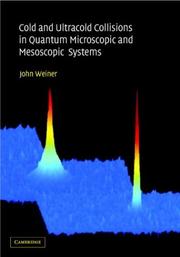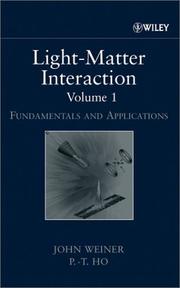| Listing 1 - 4 of 4 |
Sort by
|

ISBN: 110712915X 0511066872 1280417935 9786610417933 0511169663 0511205694 0511308493 051153521X 0511069006 9780511066870 9780511069000 9780511535215 9780521781213 0521781213 9781280417931 0521781213 9780511060564 0511060564 9780521036931 Year: 2003 Publisher: Cambridge, U.K. New York Cambridge University Press
Abstract | Keywords | Export | Availability | Bookmark
 Loading...
Loading...Choose an application
- Reference Manager
- EndNote
- RefWorks (Direct export to RefWorks)
Cold and ultracold collisions occupy a strategic position at the intersection of several powerful themes of current research in chemical physics, in atomic, molecular and optical physics, and even in condensed matter. The nature of these collisions has important consequences for optical manipulation of inelastic and reactive processes, precision measurement of molecular and atomic properties, matter-wave coherences and quantum-statistical condensates of dilute, weakly interacting atoms. This crucial position explains the wide interest and explosive growth of the field since its inception in 1987. The author reviews elements of the quantum theory of scattering theory, collisions taking place in the presence of one or more light fields, and collisions in the dark, below the photon recoil limit imposed by the presence of any light field. Finally, it reviews the essential properties of these mesoscopic quantum systems and describes the key importance of the scattering length to condensate stability.
Collisions (Nuclear physics). --- Nuclear Physics --- Physics --- Physical Sciences & Mathematics --- Collisions (Nuclear physics) --- Materials at low temperatures. --- Low temperature materials --- Low temperature engineering --- Materials --- Strength of materials --- Bombardment with particles --- Electron collisions --- Impact phenomena (Nuclear physics) --- Nuclear collisions --- Particle collisions (Nuclear physics) --- Particles (Nuclear physics) --- Collisions (Physics) --- Collisions
Book
Year: 1980 Publisher: The Hague Nijhoff
Abstract | Keywords | Export | Availability | Bookmark
 Loading...
Loading...Choose an application
- Reference Manager
- EndNote
- RefWorks (Direct export to RefWorks)
Book
ISBN: 9780198796664 Year: 2017 Publisher: Oxford Oxford University Press
Abstract | Keywords | Export | Availability | Bookmark
 Loading...
Loading...Choose an application
- Reference Manager
- EndNote
- RefWorks (Direct export to RefWorks)
Electromagnetic theory --- Electromagnetic surface waves --- Plasmons (Physics) --- Electric circuits

ISBN: 0471253774 Year: 2003 Publisher: Hoboken, N.J. : Wiley,
Abstract | Keywords | Export | Availability | Bookmark
| Listing 1 - 4 of 4 |
Sort by
|

 Search
Search Feedback
Feedback About UniCat
About UniCat  Help
Help News
News